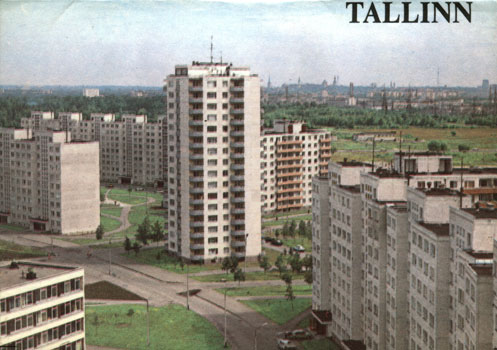
The book

G. German - Tallinn. 16 fotopostkaarti
Fotod: G. German. Tallinn. 16 fotopostkaarti
Koostaja: V. Kallion.
Tekst: T. Tilinina.
Kujundus V. Vist. Tallinn. Kirjastus "Eesti Raamat" 1985
"Eesti Raamat", 1985. L1156-L1171. 3123221. Trk. "О". T. 2411. 100 000. MB-02162...
The town wall, the red tiled roofs and ancient defense towers with copper weather-vanes catch the eye in the historical town-centre of Tallinn, the capital of the Estonian SSR.
Tallinn was first mentioned in the commentaries of the map of the world by Arabian geographer al-ldrisi (1154). The name given by al-ldrisi has been considered identical with Kolovan, the name in later Russian chronicles. In the 13th century the most-used name was Reval (Rewel), derived from the ancient county-name Revala. It was about the same time (after the Danish conquest) that the Estonian name Tallinn came into use.
The good position of the town on the hill near the trade-route, the harbour on the deep and protected bay attracted traders from far and near, and also the foreign conquerors. The town had to defend itself. A fortified zone was erected round Tallinn.
In the 13th - 14th century a number of buildings was erected in Tallinn, now known as monuments of mediaeval architecture. The ancient town is rejuvenating and getting more beautiful all the time; new houses are built and the old ones are reconstructed. Complex restoration of the old part of the town has been started in recent years. Modern Tallinn - the political, administrative, industrial and cultural centre of our republic gives evidence of great transformations in social and economic life in the recent decades.
At Vaike-Oismae and Lasnamae new housing developments for 45 thousand and 160 thousand inhabitants have been built. Many administration and industrial buildings have been erected, as well as schools and kindergartens, hostels and study blocks for higher educational establishments.
The network of facilities for sports and recreation and for cultural purposes has enlarged. In 1980 a modern Yachting Centre was opened at Pirita for the sailing regatta of the Olympic Games of Moscow; the building of the Palace of Culture and Sports named after V. I. Lenin (seating 6000), the new Air Terminal of international standards, and the 28-storied hotel Olumpia for 800 visitors was also finished in that year.
Not less attention has been paid to medical service. In 1979 a whole set of medical facilities was opened at Mustamae, the First Aid Hospital being its dominant part.
Several new shops and services houses are built every year. Construction work in our beautiful and unique Tallinn does not ever cease; the city is old, yet forever young.
|
ПОИСК:
|
© GEOGRAPHY.SU, 2010-2021
При использовании материалов сайта активная ссылка обязательна:
http://geography.su/ 'Geography.su: Страны и народы мира'

При использовании материалов сайта активная ссылка обязательна:
http://geography.su/ 'Geography.su: Страны и народы мира'